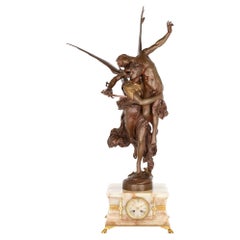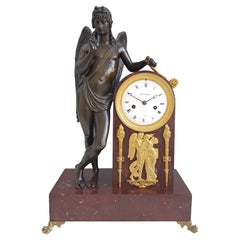Antonin Mercie Clocks
to
1
1
1
1
1
1
1
1
1
1
1
Height
to
Width
to
1
1
1
2
69
52
42
40
Creator: Antonin Mercie
Antique Patinated Bronze and Onyx Mantel Clock by Mercié and Barbedienne
By Ferdinand Barbedienne, Antonin Mercie
Located in London, GB
Antique patinated bronze and onyx mantel clock by Mercié and Barbedienne
French, Late 19th Century
Height 113cm, width 58cm, depth 40cm
Two renowned French makers, Antonin Mercié (...
Category
Late 19th Century French Neoclassical Antique Antonin Mercie Clocks
Materials
Onyx, Bronze, Ormolu
Related Items
French Empire Mantel Clock in Ormolu, Patinated Bronze and Marble, Signed Picnot
By Picnot
Located in London, GB
French Empire clock of stunning quality constructed of rouge marble, original fire gilt ormolu and patinated bronze. Set upon four ormolu paw feet to the rouge marble base, rising to...
Category
1810s French Empire Antique Antonin Mercie Clocks
Materials
Marble, Bronze, Ormolu
$9,981
H 18.5 in W 11.1 in D 5 in
Louis XVI Style Gilt-Bronze Mantel Clock by Henri Picard & Fedinand Barbedienne
By F. Barbedienne Foundry
Located in Los Angeles, CA
A Very Fine French 19th Century Gilt-Bronze Figural Mantel Clock, Horloge à Poser, by Henri Picard and Fedinand Barbedienne - ‘F. Barbédienne & Cie. / A Paris’, after the model by É...
Category
19th Century French Louis XVI Antique Antonin Mercie Clocks
Materials
Bronze, Ormolu
$46,000 Sale Price
20% Off
H 27.25 in W 22.5 in D 27.25 in
French Art Deco Champleve Enameled Bronze and Onyx Mantel Clock and Obelisks Set
Located in New York, NY
French Art Deco period mantel clock and obelisks garniture (set), circa 1920s, crafted from onyx stone with champleve enameled bronze mounts. Clock 14 1/4 inches tall and the obelis...
Category
Early 20th Century French Art Deco Antonin Mercie Clocks
Materials
Onyx, Bronze, Enamel
$5,500 / set
H 14.25 in W 14 in D 5 in
Fine Quality French Gilt and Patinated Bronze Mantel Clock
Located in New York, NY
A fine quality gilt and patinated bronze library clock surmounted on a white oblong base. Having a gilt bronze eagle finial in full relief above a ...
Category
19th Century French Antique Antonin Mercie Clocks
Materials
Marble, Bronze
A Large French Rouge Marble Gilt Patinated Bronze Mantel Clock by A. Beurdeley
By Alfred Emmanuel Louis Beurdeley
Located in Los Angeles, CA
A French Napoleon III Period Rouge Marble Gilt & Patinated Bronze Mantel Clock Alfred Emmanuel Louis Beurdeley
Movement marked: J. Lefebvre Fils Paris & Numbered1938
Movement stamped: Medaille De Bronze J. Marti & Cie & Numbered 92
Dial signed: A. Beurdeley Fila, Paris
France, Circa 1875
Dimensions: Height: 24" (61cm), Width: 22" (56cm) Depth: 11" (28cm)
Excellent Working Condition
Biography
French — Alfred Emmanuel Louis Beurdeley was a Parisian cabinetmaker who specialized in the manufacture of luxurious French furnishings...
Category
1870s French Napoleon III Antique Antonin Mercie Clocks
Materials
Marble, Ormolu, Bronze
$65,000
H 24 in W 22 in D 11 in
Gothic Bronze and Brass Mantel Clock
Located in Amersham, GB
A gothic revival bronze and brass bracket clock with a 5-inch silvered convex Roman dial. The twin fusee movement strikes on a bell, with a heavy high quality pendulum and hold fast...
Category
1830s English Gothic Revival Antique Antonin Mercie Clocks
Materials
Brass, Bronze
French Empire Ormolu and Patinated Bronze Mantel Clock
Located in London, GB
Antique French Charles X period "Au bon Sauvage" mantel clock. Very rare, this is not a model we have ever seen before, possibly a one off. Set upon f...
Category
1820s Antique Antonin Mercie Clocks
Materials
Bronze, Ormolu
19th Century Rare French Mantel Clock by F. Barbedienne with Bronze Figures
By Ferdinand Barbedienne
Located in Sofia, BG
French mantel clock by Ferdinand Barbedienne consisting of a terminal clock in the form of a fluted column in white marble and de...
Category
Mid-19th Century French Antique Antonin Mercie Clocks
Materials
Marble, Bronze
$8,957 Sale Price
44% Off
H 17.33 in W 13 in D 8.67 in
French Empire Ormolu and Patinated Bronze Mantel Clock Signed Vaillaint a Paris
Located in London, GB
Superb quality French Empire ormolu and patinated bronze mantel clock in a beautifully restrained case. The casting and gilding of the finest quality. A classically dressed maiden st...
Category
Early 1800s French Empire Antique Antonin Mercie Clocks
Materials
Ormolu, Bronze
$8,604
H 19.3 in W 11.82 in D 5.91 in
Directoire Gilt and Patinated Bronze Mantel Clock
Located in Kittery Point, ME
The oval base raised on toupie feet, centered with a panel of hunting dogs with hunting trophies on each side, the case supported by a landscaped scenery of water and rocks and surmo...
Category
Late 18th Century French Directoire Antique Antonin Mercie Clocks
Materials
Bronze
‘Gloria Victis’, A Patinated Bronze Figural Group by Mercié, Cast by Barbedienne
By Ferdinand Barbedienne
Located in Brighton, West Sussex
A Patinated Bronze Figural Group of ‘Gloria Victis’ (‘Glory to the Vanquished’), Cast by Ferdinand Barbedienne from the Model by Marius-Jean-Antonin Mercié (French, 1845-1916).
‘Gloria Victis’ (‘Glory to the Vanquished’).
Bronze, gilt and dark brown patina.
Signed 'A. Mercié', with foundry inscription 'F. BARBEDIENNE, Fondeur. Paris.' and A. Collas reduction cachet. The integral base titled 'GLORIA VICTIS'.
This cast is part of a limited edition by the Barbedienne Foundry.
France. Circa 1880.
‘Gloria Victis’ is one of the most recognisable and important works of sculpture of the nineteenth century and a definitive image of France’s historic national identity. The figure of glory, winged and wearing armour, carries a dying young warrior heavenwards towards fame and immortality. The compositional daring of the group must be admired for balancing two figures on the minimal support of one foot, wings spread in the moment before taking flight.
Mercié was a student at the French Academy of Rome when the Prussians invaded France in 1870. Shortly after the war had begun, he executed a group depicting the figure of Fame supporting a victorious soldier. When news reached Mercié in Rome that the French had surrendered, he decided to alter his group, replacing the victorious soldier with a defeated casualty, thus transforming an allegory of ‘Glory to the Victors’ into one of ‘Glory to the Vanquished’. Completed in 1872, a year after the defeat of French soldiers against the Prussian army, the statue personifies a defeated but heroic France. The title is also a reversal of the famous formula, ‘Vae Victis’ (Death to the Vanquished), which the Gallic general Brennus exclaimed upon defeating the Romans in 390 BC. The figure of the fallen soldier was thought to represent Henri Regnault, a fellow sculptor of Mercié who was killed on the last day of fighting.
Measuring 317 cm. high the original group of ‘Gloria Victis’ was unveiled in plaster at the Salon of 1872. It was bought by the City of Paris for the sum of twelve thousand francs and then cast in bronze by Victor Thiébaut for eight thousand five hundred francs. The bronze was exhibited at the Salon in 1875 and first placed in Montholon Square in the 8th arrondissement. In 1884 it was transferred to the courtyard of the Hôtel de Ville and in 1930, it entered the collection of the Musée du Petit Palais, where it can be seen to this day.
The Thiébaut Frères foundry also cast Gloria Victis bronzes for the cities of Niort (requested 1881) Bordeaux (requested 1883), Châlons-sur-Marne (today, Châlons-en-Champagne; requested 1890), and Cholet (requested 1901). In 1905, the Danish brewer and art collector Carl Jacobsen was permitted to have an exact cast made of the original sculpture in Paris, on condition that the base was made 2 cm lower and bore the inscription “Original tilhører Paris By” (The original belongs to the City of Paris). It too was cast by the Thiébaut Frères foundry. Gloria Victis was one of Jacobsen’s most important and his last acquisition. Today it has been returned to its original position in the Winter Garden at Glyptoteket, Copenhagen, Denmark.
The full-size plaster was shown again at the Paris Expositon universelle of 1878 alongside a bronze reduction by Barbedienne. By this time Antonin Mercié had entered into a commercial edition contract with the Ferdinand Babedienne foundry to produce bronze reductions of Gloria Victis, his most famous work. Gloria Victis is first recorded to have been produced in three sizes and by 1886 Barbedienne’s ‘Catalogue des Bronzes D’Art’ lists six sizes measuring 3/5, 9/20, 7/20, 3/10, 6/25 and 2/10, of the original. These reductions were produced by an invention of Barbedienne’s business partner Achille Collas. The Collas reducing machine was a type of complex mechanical pantograph lathe that enabled sculpture to be mathematically measured and transcribed to scale, in the round, thus making a reduced size plaster from which a bronze could be cast.
Mercié's modern sculpture had become an instant classic, even receiving an entry in the Nouveau Larousse Illustré. The success of the group undoubtedly lay in the fact that it was admired not just on an aesthetic level, but also on a patriotic level, particularly in its commemoration of heroism in defeat. Immediately ‘Gloria Victis’ was recognised as a national artwork, capable of arousing patriotism and casts were ordered from Barbedienne as local memorials commemorating the war’s dead for cities across France. ‘Gloria Victis’ was considered so much a part of France’s national identity that for the 1900 Paris Exhibition, Ferdinand Barbedienne’s nephew Gustave Leblanc, loaned a bronze example to feature as part of l’Exposition centennale de l’art français.
Literature:
For an interesting account of the process of creating a reduction in bronze of the Gloria Victis by Barbedienne and illustrations of the casting and finishing of the bronze see:
'Ferdinand Barbedienne': Theodore Child; Harper's new monthly magazine, Volume 73, Issue 436, September 1886.
‘Contemporary French Sculptors’: The Century, Volume 33, Issue 3, Jan 1887.
‘Modern French Sculpture’: Harper's new monthly magazine, Volume 76, Issue 452,
January 1888.
S, Lami, ‘Dictionnaire des sculpteurs de l'Ecole française au dix-neuvième siècle’, Tome III. G.-M., Paris, 1914, p. 432.
Peter Fusco and H.W. Janson, The Romantics to Rodin: French Nineteenth Century Sculpture from North...
Category
19th Century French Antique Antonin Mercie Clocks
Materials
Bronze
$49,564
H 41.74 in W 16.54 in D 14.18 in
Exceptional 19th Century Bronze Entitled ““Quand Meme” by Mercié and Barbedienne
By Ferdinand Barbedienne, Antonin Mercie
Located in Long Island City, NY
A Large and Exceptional Late 19th Century Patinated Bronze Figural Group Entitled “Quand Meme” by Mercié and Barbedienne on Pedestal
Marius-Jean-Antonin Me...
Category
Late 19th Century French Belle Époque Antique Antonin Mercie Clocks
Materials
Bronze
$65,000 / set
H 50 in W 27 in D 22 in
Antonin Mercie clocks for sale on 1stDibs.
Antonin Mercie clocks are available for sale on 1stDibs. These distinctive items are frequently made of stone and are designed with extraordinary care. Many of the original clocks by Antonin Mercie were created in the neoclassical style in france during the 19th century. If you’re looking for additional options, many customers also consider clocks by and Ferdinand Barbedienne. Prices for Antonin Mercie clocks can differ depending upon size, time period and other attributes — on 1stDibs, these items begin at $57,992 and can go as high as $57,992, while a piece like these, on average, fetch $57,992.


